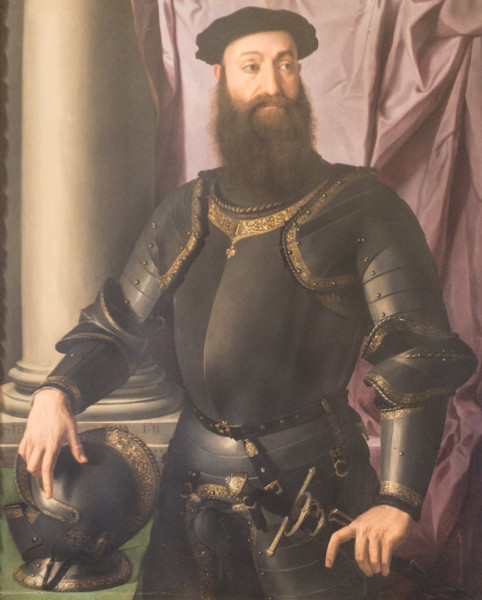
Portrait of Stefano Colonna, Bronzino, fragment, Galleria Nazionale d’Arte Antica, Palazzo Barberini

Portrait of Stefano Colonna, Bronzino (Agnolo di Cosimo), Galleria Nazionale d’Arte Antica, Palazzo Barberini

Portrait of Stefano Colonna, Bronzino, Galleria Nazionale d’Arte Antica, Palazzo Barberini

Portrait of Stefano Colonna, Bronzino fragment, Galleria Nazionale d’Arte Antica, Palazzo Barberini
Here we have a true hero of his times. The proud representative of the influential Roman Colonna family, but most of all a valued condottiero, who during his whole lifetime fought on numerous fronts, under the banners of numerous rulers. His abilities were valued by the emperor, the king of France, the pope, the Venetian doge, the duke of Florence, meaning all those for whom war was an obvious part of everyday life.
Here we have a true hero of his times. The proud representative of the influential Roman Colonna family, but most of all a valued condottiero, who during his whole lifetime fought on numerous fronts, under the banners of numerous rulers. His abilities were valued by the emperor, the king of France, the pope, the Venetian doge, the duke of Florence, meaning all those for whom war was an obvious part of everyday life.
We are in Europe of the Cinquecento period, wrought by constant conflicts over influence, land, prestige, and religion. In order to wage a war, one had to have leaders who were experienced in battle. These were professional mercenaries, the so-called condottieri, and the fates of the rulers of Europe depended on their skills. No one was surprised by the constant changes in their clients and war fronts. The highest bidder won, while loyalty was a rare commodity indeed and subject to many fluctuations. One could speak of sympathies at the most, but even these were not treated very rigorously.
Stefano Colonna IV from Palestrina was a typical condottiero of the Renaissance period. His military services were highly valued, while the rulers who employed him had little to complain about. At the beginning he served under the banners of Emperor Charles V, to then during the Sacco di Roma, switch sides and aid the emperor’s enemy – Pope Clement VII; and it was then that he became famous for being a skilled leader. After an armistice was concluded between the emperor and the pope Stefano went to France, to join the armies of King Francis I and fight against the emperor. He also offered his services to the next pope, Paul III. In 1541 he was called up by the Duke of Florence, Cosimo I to reorganize his army. In the city on the Arno, the condottiero received a stable salary and the title of general, as well as the time to develop his other interests, besides the military ones. He befriended members of the Academy of Florence, reportedly he enjoyed reading books, and if that was not enough he himself developed some poetry. We do not know the exact date of his birth (between 1490 and 1500), but he may have been around 50 years old when he met the valued in Florence Bronzino. And it was him that the general entrusted with painting his own portrait. There was probably no higher evidence of prestige than an image created by the hand of the court painter of the duke of Florence. Portraits by this artist emanated with distinctiveness, monumental majesty, and had to appeal to the condottiero. This was even more true because they were ordered not only by the duke himself and his family but also by other leaders (Guidobaldo della Rovere, 1530). They were valued because of their harmony, purity of colors, impeccable modeling, and realism in depicting the portrayed. Giorgio Vasari, who was a great enthusiast of Bronzino's talent claimed that he was able to paint such natural portraits, that their protagonists seemed to be alive "so alive that they even had a soul". However, we must be careful when listening to those praises. The most magnificent of Bronzino's portraits – those depicting the then Florentine writers and intellectuals – truly emanated a certain spirituality in contrast with the images of soldiers which he created, which speak to us mainly with their grandeur, although it must be admitted, expressed with great expertise of the painter’s workshop.

Another characteristic of the portrait painting of Bronzino was perfection in recreating precious fabrics, jewelry, and shining armor. It is the same in this portrait, where an important, or perhaps even principal role is played by the armor, sword, and helmet, integral attributes of a warrior, a clear testimony to his profession. Behind these attributes is the figure of our hero. We recognize him due to his bushy beard, long nose, and distinct, large eyes. However, the painter betrays neither his spiritual condition nor his emotions. In exchange, he provides us with precisely depicted, miniature, inlaid with gold, elements of his helmet, sword, and armor. The painting also had to include a curtain hanging in the background and a column which in this case is a significant attribute of the portrayed – a direct reference to the coat of arms of the Colonna family from which the general came. At its base, his name is also inscribed. Even the gilded frame is a reminder of Colonna's profession and his military virtues if indeed professional killing can be seen as a virtue.
The general died in 1548, meaning two years after the portrait was created. The painting was exhibited at his burial, during the funeral ceremonies in the Florentine Church of San Lorenzo.
Portrait of Stefano Colonna, Bronzino (Agnolo di Cosimo), 1546, oil on wood, 125 x 95 cm, Galleria Nazionale d’Arte Antica, Palazzo Barberini

















